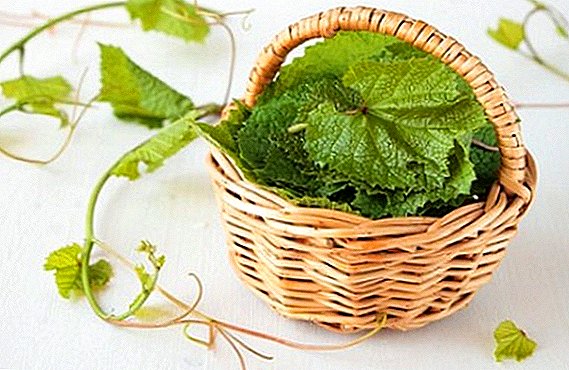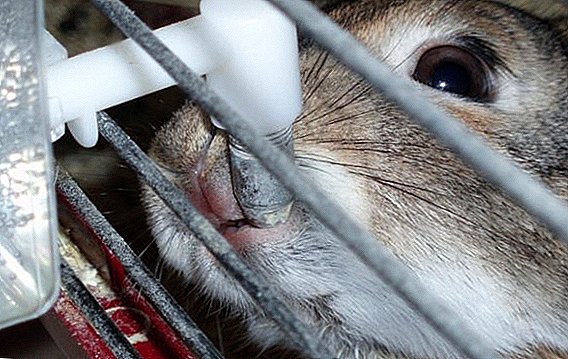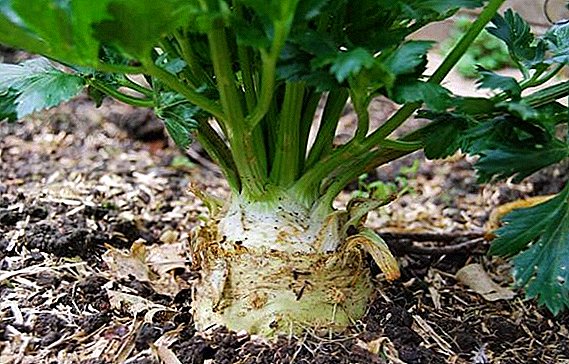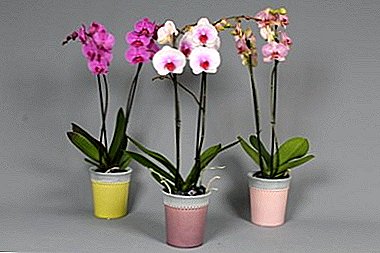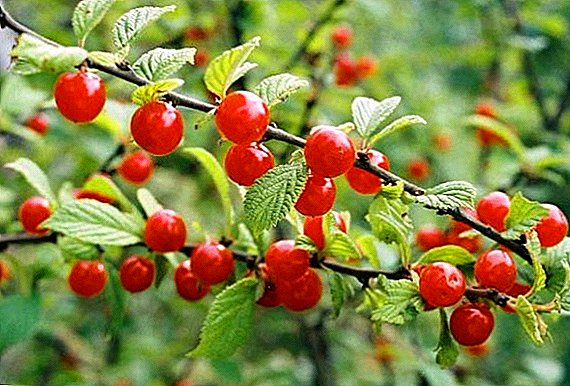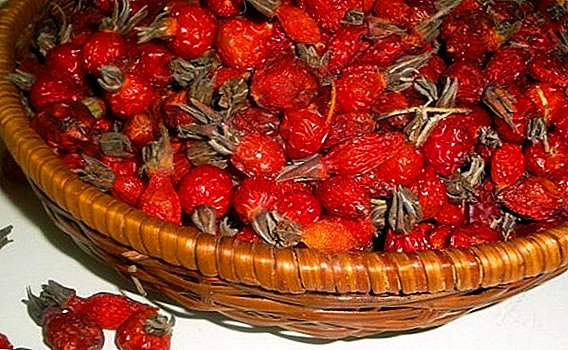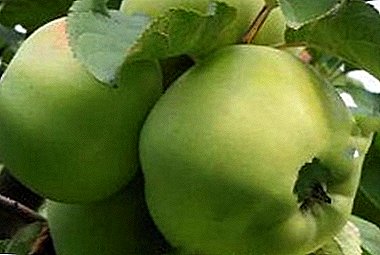
Every person has a wonderful smell of grandmother’s cake, an unforgettable taste of her berry jam, beauty of a shady grandmother’s garden among childhood memories.
So, someone's warm and touching memories gave the name to the sort born by the people "Grandmother's apple".
What is the role in creating new varieties?
 The role of the Babushkino apple variety in the selection of other varieties ”> We find an explanation for the name in the historical joke (not to be confused with humorous folklore!): Tula landowner, resting in the Crimea, intended to bring an apple variety to her garden.
The role of the Babushkino apple variety in the selection of other varieties ”> We find an explanation for the name in the historical joke (not to be confused with humorous folklore!): Tula landowner, resting in the Crimea, intended to bring an apple variety to her garden.
In the opinion of A.Petrov's pomolog, her choice allegedly fell on Rennet Champagne.
The lady was very lucky - after all, an ordinary wilderness could grow from apple seeds, but out of a dozen seedlings the most promising fruit quality was chosen.
Grandchildren began to call him "grandmother's" tree. And, subsequently, the name in the popular rumor was firmly established for the apple of this species as a varietal.
The State Register of Apples variety Grandma did not includealthough it is still found in private gardens from Voronezh to St. Petersburgcovering the whole central region. High winter hardiness, resistance to scab, excellent taste qualities advanced this variety in creating new winter species of apple trees for the important role of stock:
| New variety | Graft and pollinators | View | Fruit weight (in gr.) | Acquired merits |
|---|---|---|---|---|
| Autumn Scarlet | Mekintosh | Late autumn | 125 (up to 100kg from wood) | Fruiting for 15 year; |
| Banana | Winter banana | winter | 140 | High yield; storage until May. |
| Chashnikovskoe | Cinnamon Striped + Rennet Champagne | winter | 140 | Low; storage up to 150 days; yield (218 c / ha). |
| Vesylina | Loves | winter | 150 | Fruiting for 2-3 years; |
| Antonovka New | Antonovka ordinary | winter | 200 | ripening (4-5 year); resistant to scab. |
| Russian woman | Antonovka ordinary | Pre-winter | 200 | Fruiting from 5-6 years; resistant to scab; therapeutic properties of hypertension. |
| Isaev's gift | Antonovka ordinary | winter | 200 | High content of vitamin "C"; storage until April; on state tests not passed. |
| Antey | Belarusian Crimson + Newton | winter | 250 | Early maturation (2-3 years); resistant to scab. |
| Palm | Loves | winter | 250 | Fruiting for 2-3 years; resistant to scab; storage until May. |
Antonovka vulgaris, Aport, the Covenant, Borovinka and Granny Smith are the most popular ones.
What breeding problem solves?

- High winter hardiness.
- Immunity to fungal and putrid diseases.
- Good yield.
- Commercial appearance of fruits of medium size.
- Duration of storage (some varietal derivatives are stored until the new harvest).
- Fruits are an excellent raw material for processing.
- Grandma's apples do not lose consumer demand over the years.
Reference: The apple tree of this variety from the end of the 19th to the 20th century was considered as the basis of industrial gardening in the central part of Russia.
The yield of the same kind can demonstrate such varieties: Borovinka, Volzhanka, Jonathan, Prima and Uslada.
A photo


Varietal features
- This fruit tree belongs to self-infertile. This means that in order to get the ovary, he cannot do without the help of another apple, acting as a pollinator. The main carrier of pollen from tree to tree are bees that are engaged in honey collection in a radius of 2 kilometers.
For the successful fruiting of the Grandmother's apple, at least one pollinator tree in the district will suffice.
Suitable for this purpose: Papirovka, Antonovka ordinary, Shtreyfling, Cinnamon striped, Borovinka.
For pollination efficiency matters:
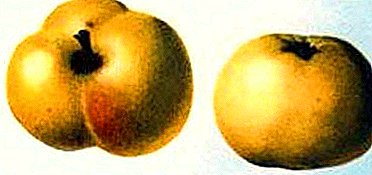
- what varietal virtues a pollinator can convey;
- Do the flowering and fruiting phases coincide in time?
- how is the process of pollination of pollinators themselves.
Important: If there are no pollinating trees in the garden, then it is important to coordinate your interests with the neighbors in the area, or to explore the surrounding planting of garden plants within a radius of 2 km.
- Plant of this variety applies to winter species. This means that the final ripening of the fruit does not occur during the harvest period (at the end of September), but after a month or more, when the crop is stored for storage. The taste of such an apple (with proper storage) does not lose until the end of spring.
The winter varieties also include apple trees: Belfleur Bashkir, Bryansk Golden, Dzhonagold, Amazing and Lada.
- The yield of the variety is characterized by frequency (in a year).
- Apple tree develops slowly. Regularly fruiting tree begins quite late: the first harvest has to wait 10-15 years. But in the reproductive activity, it can be up to 50 and even 100 years.
- Winter hardiness of a grade is defined characteristic for an average strip of Russia winter temperature drops, early autumn and late frosts in the spring. But north of the Leningrad region, this apple is not cultivated.
- Plant Immune to fungal and putrid diseases (scab), but may be subject to a moth infestation.
Resistance to scab have varieties: Hero of the Day, Rennet Chernenko, Zhigulevskoe, Bogatyr and Berkutovskoe.
- Grandma's Apple Fruits rich in vitamin "C", low-calorie, have a therapeutic effect when they are systemically used by hypertensive patients. In the processing of them are jam, marmalade, candied fruit, jam, juice, fruit drinks.
- Grandma's apples well tolerated transportation, storage in cellars, in attics at the optimum temperature - 0-1oС.

Appearance
Consider separately the appearance of the tree and the fruit.
Tree
 Tree reaches 5 meters tall, medium height, with a lush spherical crown, the lower branches of which tend to the ground.
Tree reaches 5 meters tall, medium height, with a lush spherical crown, the lower branches of which tend to the ground.
The structure of the tree is durable and healthy, the wood is hard and heavy, which was the reason to use it for breeding as a stock.
Skeleton branches are powerful and well-shaped, upturned slightly upwards. Both branches and shoots have a bark of a light color. Kidneys are small, tightly pressed.
The leaves are light green, rounded, spoon-shaped, small, with a notched not very toothed margin. Lightly pubescent. Attached to the branch average in thickness and length of the petioles. The vegetative processes in them end by the middle of summer, which leads to intensive leaf fall in late July - early August.
Flowers are collected in inflorescences of 3-5 pieces. In the buds look pink, but when opened, become white. In size, they are quite large, of five petals, fused into the five-nest pestles and 20 stamens with anthers. The flowering phase occurs in the third decade of May.
Fruit
Fruit medium size (up to 150 g.) with a characteristic surface irregularity, forming wide ribs. They are attached to the branch by a short stem. Color uniform: green, when ripe - yellow. Sometimes the lighted side gets a faint blush. The skin is thick, slightly waxed, with embossed white dots. The flesh is juicy and white, the taste is sweet and sour, with a delicate aroma and wine flavor.
Where to plant?
 Surely him like on fertile southern slopes, sheltered from strong winds, so that the sun shines on it for 6-7 hours a day. With a large slope, the slopes need to be strengthened with retaining walls of foam blocks, stakes driven into the ground, or weave a weave to keep the land from erosion.
Surely him like on fertile southern slopes, sheltered from strong winds, so that the sun shines on it for 6-7 hours a day. With a large slope, the slopes need to be strengthened with retaining walls of foam blocks, stakes driven into the ground, or weave a weave to keep the land from erosion.
The place should be chosen taking into account the plant environment, away from the kitchen and the veranda, since with uneven ripening the fruits can crumble, and carrion attracts flies, annoying people.
Landing groundwater will be disastrous for a young tree, because some apple roots go down to 4 meters. High bedding will not allow the tree to consolidate. To prevent this trouble, sometimes trees are planted on artificial hills or beds, if there are several trunks in planting. Raised stretch of soil strengthened around, as it is done on a slope.
Before landing should be checked soil acidity: apple trees do not like its high performance. In this case, you have to add lime to the soil. And, of course, you should not plant a young tree at or near the old one.
Landing process
The key to success and abundant future harvest will be:
- correctly selected time;
- properly prepared soil;
- viable seedling;
- precision landing technology.
 You can plant an apple tree spring (late April) and autumn (mid-October), but when planting in autumn, the seedling root system has more time to adapt and prepare for the vegetative period.
You can plant an apple tree spring (late April) and autumn (mid-October), but when planting in autumn, the seedling root system has more time to adapt and prepare for the vegetative period.
If the plans were not destined to be realized, and the autumn term is missed, it is better to leave the seedlings before winter prikopannymi, and plant - in early spring. The main indicator of spring planting should be temperature stability, dry, but cloudy weather.
Place of landing - a pit with a diameter of 1.2 m, a depth of 0.7 m is harvested a month before landing. Before the procedure, it is filled with 1/3 organic fertilizer.
In the middle of the pit they drive in a stake, which will serve as a support for the not strong trunk. On the formed cone of loose, fertilized soil, gently spread the roots of the seedling and cover it with earth, leaving the root neck at the surface.
Soil around the trunk trampled down and watered abundantly (up to 5 buckets). At the end, the trunk circle is mulched with peat or humus. Fixing the barrel to the peg should not be traumatic for the next two years.
Important: Repeated watering to produce in a week, and so - until August.
 Fruit tree from sunflower seeds? Tedious and thankless task. Buy a sapling of any grade - an absolutely affordable market offer.
Fruit tree from sunflower seeds? Tedious and thankless task. Buy a sapling of any grade - an absolutely affordable market offer.
It is important that it is strong, healthy, without damaging the branches and roots and signs of rotting. If the leaves have already appeared, they should be carefully removed without damaging the sleeping buds.
Considered suitable two or three years, although a one-year-old seedling can also be planted in the ground.
Fruit tree care technology for a bountiful harvest includes:
- loosening and watering;
- fertilization;
- pruning branches;
- pest and disease control;
- harvesting;
- preparation for the rest period (winter).
What can trouble the gardener?
 For the Grandma apple variety, this set of measures is typical, as for most apple trees. Especially since this plant different unpretentiousso willingly cultivated in popular selection.
For the Grandma apple variety, this set of measures is typical, as for most apple trees. Especially since this plant different unpretentiousso willingly cultivated in popular selection.
Wormholes - traces of vital activity of butterfly moth larvae. After wintering under the bark of the tree, immediately after flowering, they are born to continue the cycle of life: after sunset, they lay up to 160 eggs in the ovary and on the leaves.
Fifteen days later, the caterpillars begin to eat the fruit: start with the pulp, then eat the seeds and go to the next apple.
The forms of struggle are different:
- chemical (spraying with ready-made preparations: "Dimethoat", "Iskra M", "Bi-58", etc.);
- biological (spraying "Bitoxibacillin");
- mechanical (trapping belts, digging around the trunk within the autumn period, burning the affected fragments of the old bark);
- folk (infusions of needles, tansy, wormwood; replanting mustard bushes, tomato, dill near trees);
- prophylactic (the more flowering plants in the garden, the less chance that the moth will live exclusively on the apple tree;
- you need to remove the drop in time;
- harvest should be stored in boxes without cracks).
It is also not necessary to neglect preventive measures against the fruit sap, haws, miner moths and silkworms.
How many generations have Grandma's apples improved? And how much more remains to be! After all, the varieties bred by the people in the people also acquire eternal life.




